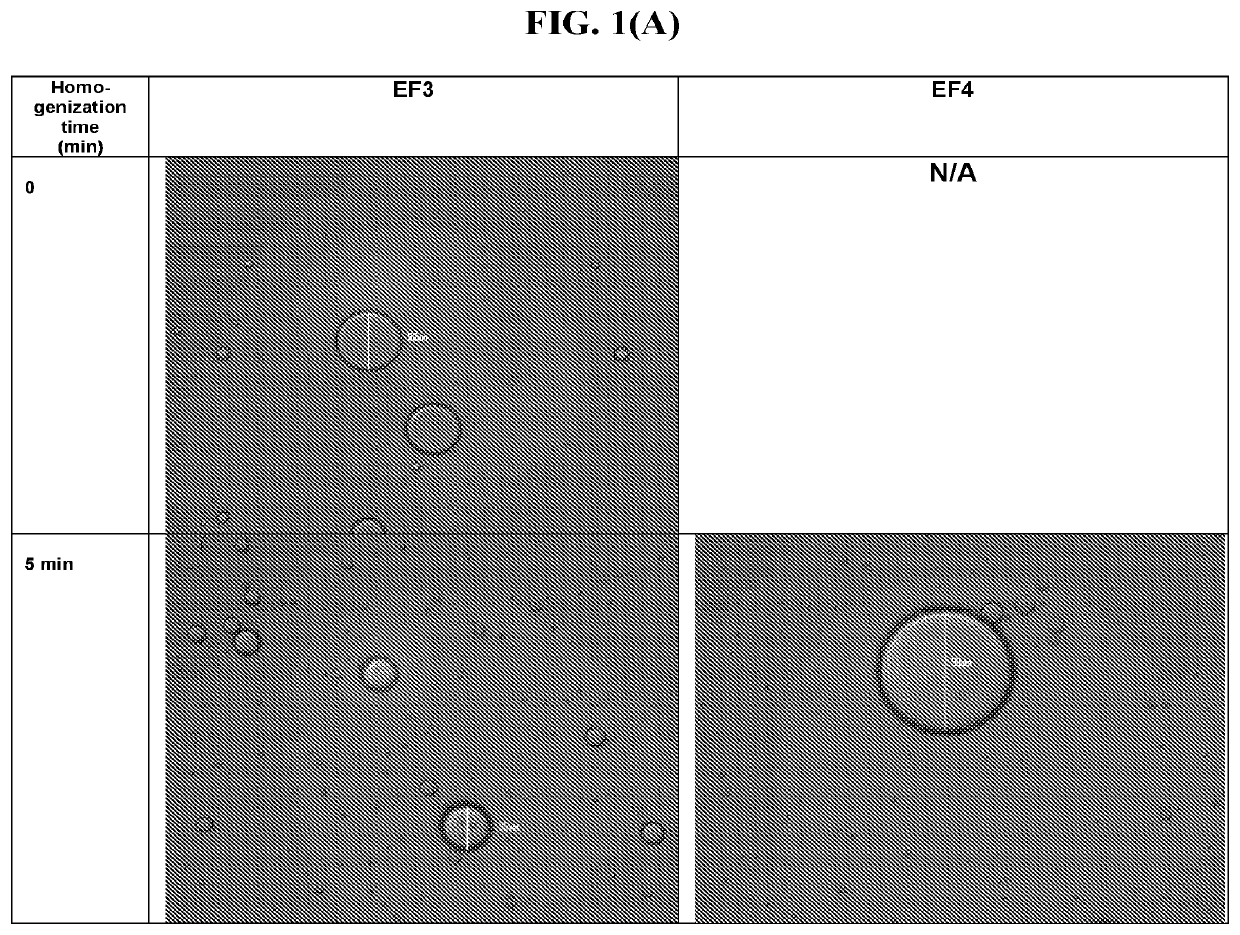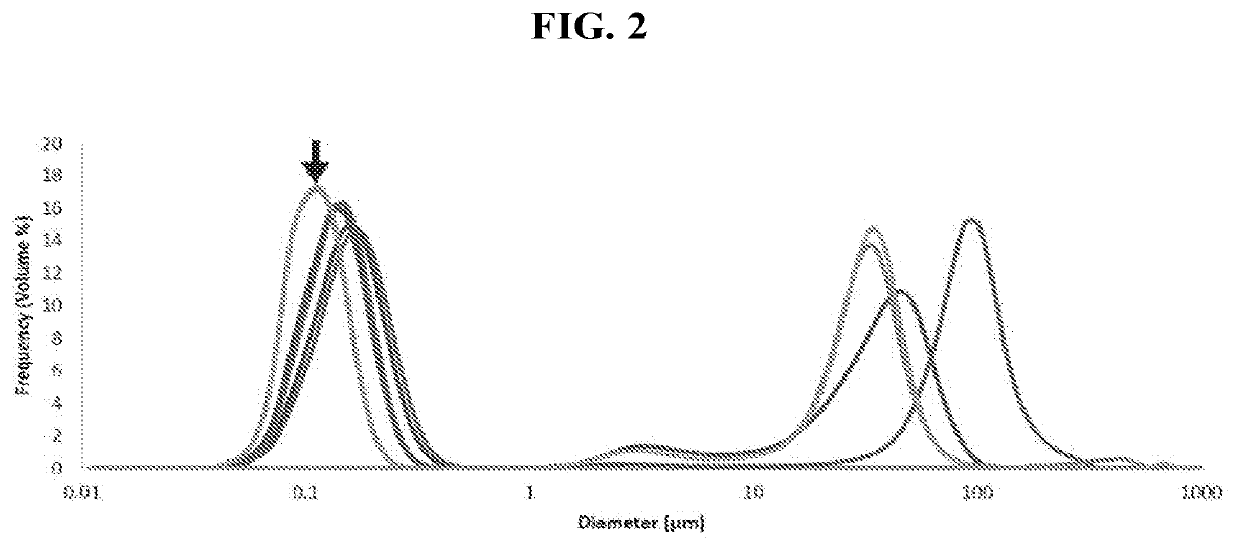Pharmaceutical compositions for the treatment of ophthalmic conditions
a technology of ophthalmic conditions and pharmaceutical compositions, applied in the direction of drug compositions, inorganic non-active ingredients, aerosol delivery, etc., can solve the problems of lipophilic drugs presenting a formulation challenge for scientists, lipophilic dosage forms for ocular application, and vision loss and blindness
- Summary
- Abstract
- Description
- Claims
- Application Information
AI Technical Summary
Benefits of technology
Problems solved by technology
Method used
Image
Examples
example 1
ty to Prepare an Emulsion of Sesame Oil in Water in the Presence of a Surfactant by Homogenization
[0162]In this example, feasibility to prepare an emulsion of sesame oil in water in the presence of a surfactant by homogenization was explored.
[0163]Model surfactant formulations comprising 7% polyoxyl 40 stearate (EF3) and 0.3% Tyloxapol (EF4) were prepared. The surfactant concentrations used in the model formulations were chosen to span the range of suitable dosage concentrations for ophthalmic use. Surfactants having similar hydrophile-lipophile balance (HLB) values were selected: the HLB of polyoxyl 40 stearate is 16.7; the HLB value of Tyloxapol is 12.9.
[0164]Surfactant and sesame oil were added to 80% batch quantity of water for injection (WFI) and mixed for about 30 minutes using a magnetic stir plate to form the EF3 and EF4 formulations (Table 1).
TABLE 1EF3 and EF4 FormulationsReagent, %(w / w)EF3EF4SurfactantPolyoxyl 40 stearate, 7%Tyloxapol, 0.3%Sesame oil2%2%WaterAdded to 100%...
example 2
Surfactant on an Emulsion of Sesame Oil in Water Suitable for Ophthalmic Use
[0166]In this example, optimal pH and osmolarity ranges for the compositions were evaluated.
[0167]Model formulations comprising 7% Polyoxyl 40 Stearate (PE3) and 0.3% Tyloxapol (PE4) were prepared. Surfactant and sesame oil (1.5%) were added to 80% batch quantity of WFI and mixed using a magnetic stir plate. Once the mixtures appeared homogeneous, the samples were diluted up to the desired volume and pH and osmolarity of the solutions were measured. 1N NaOH was used to adjust the pH to 6.8-7.0. NaCl was used to adjust osmolarity of the samples to 270-310 mOsm / L. The results are shown below in Table 2.
TABLE 2Optimization of pH and Osmolarity During Homogenization7% Polyoxyl40 Stearate0.3% TyloxapolAdjustmentsplacebo (PE3)placebo (PE4)pHInitial pH4.85.9adjustmentNaOH added (mM)0.55pH after adjustment7.06.9OsmolarityInitial241adjustmentosmolarity (mOsm / L)NaCl added (% w / w)0.750.85Osmolarity after304292adjustmen...
example 3
l in Water Emulsion Preparations with Surfactants of Various HLB's
[0169]In this example, emulsion formulations PE1-PE10 were prepared as shown in Table 3. These samples were prepared using the method described in Example 1 (homogenized for 15 min at 3000 rpm).
TABLE 3Emulsion FormulationsFormulation DesignationReagentPE1PE2PE3PE4PE5PE6PE7PE8PE9PE10Polyoxyl2.0%————2.0%————35 castor oil(12.7)Polyoxyl 40—2.0%————2.0%———hydrogenatedCastorOil (14.1)Polyoxyl 40——2.0%————2.0%——stearate(16.7)Tyloxapol———2.0%————2.0%—(12.9)Tween 80————2.0%————2.0%(15)Sesame oil1.5%1.5%1.5%1.5%1.5%1.5%1.5%1.5%1.5%1.5%Glycerine————— 2.25% 2.25% 2.25% 2.25% 2.25%NaCl 0.85% 0.85% 0.85% 0.85% 0.85%—————NaOH (forq.s.q.s.q.s.q.s.q.s.q.s.q.s.q.s.q.s.q.s.pHadjustment)WFIq.s.q.s.q.s.q.s.q.s.q.s.q.s.q.s.q.s.q.s.
PUM
| Property | Measurement | Unit |
|---|---|---|
| diameter | aaaaa | aaaaa |
| pore size | aaaaa | aaaaa |
| diameter | aaaaa | aaaaa |
Abstract
Description
Claims
Application Information
 Login to View More
Login to View More - R&D
- Intellectual Property
- Life Sciences
- Materials
- Tech Scout
- Unparalleled Data Quality
- Higher Quality Content
- 60% Fewer Hallucinations
Browse by: Latest US Patents, China's latest patents, Technical Efficacy Thesaurus, Application Domain, Technology Topic, Popular Technical Reports.
© 2025 PatSnap. All rights reserved.Legal|Privacy policy|Modern Slavery Act Transparency Statement|Sitemap|About US| Contact US: help@patsnap.com



